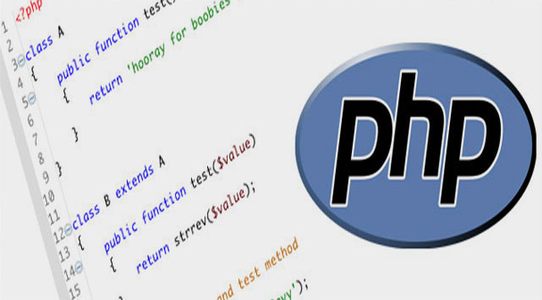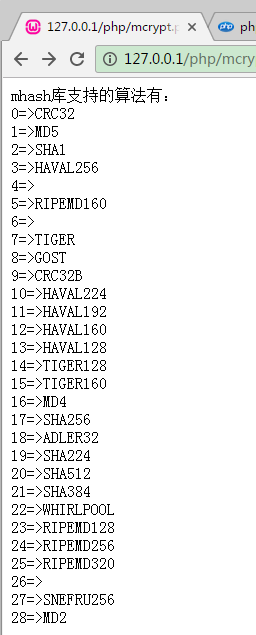Detailed summary of php encryption extension
PHP encryption extension library—Mhash extension library What is the Mhash extension library: Mhash is an irreversible PHP encryption extension library based on the principle of discrete mathematics. It is not enabled by default. mhash can be used to create verification values, message digests, message authentication codes, and save key information (such as passwords) without the original text. 1. Mhash extension library installation The installation of the Mhash library is similar to the installation of the Mcrypt extension library. I won’t go into more details here. You can refer to the previous article "PHP Encryption Extension Library—Mcrypt Extension Library"! 2. Mhash extension library constants The Mhash library supports multiple hashing algorithms such as MD5, SHA, CRC32, etc. You can use the mhash_count() and mhash_get_hash_name() functions to output the supported algorithm names. Let’s take a look at the sample code:
1. 10 recommended articles about the crypt() function

Introduction: PHP encryption extension library—Mhash extension library What is Mhash extension library: Mhash is an irreversible PHP encryption extension library based on the principle of discrete mathematics. It is not enabled by default. mhash can be used to create verification values, message digests, message authentication codes, and save key information (such as passwords) without the original text. 1. Mhash extension library installation The installation of Mhash library is similar to the installation of Mcrypt extension library. I won’t introduce it here. You can refer to the previous article "PHP Encryption Extension Library-Mcrypt Extension Library...
2. About php encryption method example usage summary

##Introduction: PHP encryption extension library—Mhash extension library What is Mhash extension library: Mhash is an irreversible PHP encryption extension library based on the principle of discrete mathematics. It is not enabled by default. mhash can be used to create verification values, message digests, message authentication codes, and save key information (such as passwords) without the original text. 1. Mhash extension library installation The installation of Mhash library is similar to the installation of Mcrypt extension library. I won’t introduce it here. You can refer to the previous article "PHP Encryption Extension Library-Mcrypt Extension Library...
3. Summary of the article on how to use the encryption extension library

Introduction: PHP encryption extension library—Mhash extension library What is the Mhash extension library: Mhash is an irreversible PHP encryption extension library based on the principle of discrete mathematics. It is not enabled by default. mhash can be used to create verification values, message digests, message authentication codes, and save key information (such as passwords) without the original text. 1. Mhash extension library installation The installation of Mhash library is similar to the installation of Mcrypt extension library. I won’t introduce it here. You can refer to the previous article "PHP Encryption Extension Library-Mcrypt Extension Library...
4. Summary of the use of php encryption extension mcrypt

5.
PHP encryption extension library-Mhash Detailed explanation of usage of extension library examples
 ## Introduction: What is Mhash extension library: Mhash is based on the principle of discrete mathematics An irreversible PHP encryption extension library, which is not enabled by default. mhash can be used to create verification values, message digests, message authentication codes, and save key information (such as passwords) without the original text.
## Introduction: What is Mhash extension library: Mhash is based on the principle of discrete mathematics An irreversible PHP encryption extension library, which is not enabled by default. mhash can be used to create verification values, message digests, message authentication codes, and save key information (such as passwords) without the original text.
6.
PHP encryption extension library—Mcrypt extension library example usageIntroduction: Before starting the main text of this article, let’s first understand what the PHP encryption extension library is: There are not only several encryption functions in PHP ( md5, crypt, sha1), in addition, there are some comprehensive encryption extension libraries in PHP! Just like PHP does not originally support operating a certain function, but if you want to support it in the new version, you can provide it in an extended way. In this way, when we configure PHP, if we do not use this function, we can prevent PHP from loading. It thus saves server resources and improves its performance. 7. Details introduce the basic use of PHP encryption extension mcrypt ##Introduction: Mcrypt supports the following four block cipher modes: CBC, OFB, CFB and ECB. If linked with libmcrypt-2.4.x or higher, nOFB grouped mode and streaming mode are also supported. The following are the supported encryption modes and their corresponding predefined constants. 1. MCRYPT_MODE_ECB (electronic codebook) is suitable for random data. For example, this mode can be used to encrypt other keys. Since the data to be encrypted is very 8. Summary on using PHP’s openssl encryption extension (recommended) Introduction: The editor below will bring you a summary of the use of PHP's openssl encryption extension (recommended). The editor thinks it’s pretty good, so I’ll share it with you now and give it as a reference. Let’s follow the editor and take a look. 9. Summary of using PHP’s openssl encryption extension Introduction: The following editor will bring you a summary of the use of PHP's openssl encryption extension (recommended). The editor thinks it’s pretty good, so I’ll share it with you now and give it as a reference. Let’s follow the editor to take a look 10. PHP 3DES encryption algorithm implementation Introduction: What I need to do recently is that php returns a 3des encrypted URL to .net, and then the .net side decrypts it. The implementation of php has never been able to match the .net end. I will write it down here first and hope to see some guidance from experts. There are countless people on the Internet who copy and copy without verifying it personally. I hope everyone can adhere to the rigorous method in the future. Before the PHP encryption extension library Mcrypt encrypts and decrypts data, it first creates an initialization vector, referred to as iv for short. From $iv = mcrypt_create_iv(mcrypt_g ...




The above is the detailed content of Detailed summary of php encryption extension. For more information, please follow other related articles on the PHP Chinese website!

Hot AI Tools

Undresser.AI Undress
AI-powered app for creating realistic nude photos

AI Clothes Remover
Online AI tool for removing clothes from photos.

Undress AI Tool
Undress images for free

Clothoff.io
AI clothes remover

Video Face Swap
Swap faces in any video effortlessly with our completely free AI face swap tool!

Hot Article

Hot Tools

Notepad++7.3.1
Easy-to-use and free code editor

SublimeText3 Chinese version
Chinese version, very easy to use

Zend Studio 13.0.1
Powerful PHP integrated development environment

Dreamweaver CS6
Visual web development tools

SublimeText3 Mac version
God-level code editing software (SublimeText3)

Hot Topics
 Alipay PHP SDK transfer error: How to solve the problem of 'Cannot declare class SignData'?
Apr 01, 2025 am 07:21 AM
Alipay PHP SDK transfer error: How to solve the problem of 'Cannot declare class SignData'?
Apr 01, 2025 am 07:21 AM
Alipay PHP...
 Explain JSON Web Tokens (JWT) and their use case in PHP APIs.
Apr 05, 2025 am 12:04 AM
Explain JSON Web Tokens (JWT) and their use case in PHP APIs.
Apr 05, 2025 am 12:04 AM
JWT is an open standard based on JSON, used to securely transmit information between parties, mainly for identity authentication and information exchange. 1. JWT consists of three parts: Header, Payload and Signature. 2. The working principle of JWT includes three steps: generating JWT, verifying JWT and parsing Payload. 3. When using JWT for authentication in PHP, JWT can be generated and verified, and user role and permission information can be included in advanced usage. 4. Common errors include signature verification failure, token expiration, and payload oversized. Debugging skills include using debugging tools and logging. 5. Performance optimization and best practices include using appropriate signature algorithms, setting validity periods reasonably,
 How does session hijacking work and how can you mitigate it in PHP?
Apr 06, 2025 am 12:02 AM
How does session hijacking work and how can you mitigate it in PHP?
Apr 06, 2025 am 12:02 AM
Session hijacking can be achieved through the following steps: 1. Obtain the session ID, 2. Use the session ID, 3. Keep the session active. The methods to prevent session hijacking in PHP include: 1. Use the session_regenerate_id() function to regenerate the session ID, 2. Store session data through the database, 3. Ensure that all session data is transmitted through HTTPS.
 Describe the SOLID principles and how they apply to PHP development.
Apr 03, 2025 am 12:04 AM
Describe the SOLID principles and how they apply to PHP development.
Apr 03, 2025 am 12:04 AM
The application of SOLID principle in PHP development includes: 1. Single responsibility principle (SRP): Each class is responsible for only one function. 2. Open and close principle (OCP): Changes are achieved through extension rather than modification. 3. Lisch's Substitution Principle (LSP): Subclasses can replace base classes without affecting program accuracy. 4. Interface isolation principle (ISP): Use fine-grained interfaces to avoid dependencies and unused methods. 5. Dependency inversion principle (DIP): High and low-level modules rely on abstraction and are implemented through dependency injection.
 How to debug CLI mode in PHPStorm?
Apr 01, 2025 pm 02:57 PM
How to debug CLI mode in PHPStorm?
Apr 01, 2025 pm 02:57 PM
How to debug CLI mode in PHPStorm? When developing with PHPStorm, sometimes we need to debug PHP in command line interface (CLI) mode...
 Framework Security Features: Protecting against vulnerabilities.
Mar 28, 2025 pm 05:11 PM
Framework Security Features: Protecting against vulnerabilities.
Mar 28, 2025 pm 05:11 PM
Article discusses essential security features in frameworks to protect against vulnerabilities, including input validation, authentication, and regular updates.
 How to automatically set permissions of unixsocket after system restart?
Mar 31, 2025 pm 11:54 PM
How to automatically set permissions of unixsocket after system restart?
Mar 31, 2025 pm 11:54 PM
How to automatically set the permissions of unixsocket after the system restarts. Every time the system restarts, we need to execute the following command to modify the permissions of unixsocket: sudo...
 What are Enumerations (Enums) in PHP 8.1?
Apr 03, 2025 am 12:05 AM
What are Enumerations (Enums) in PHP 8.1?
Apr 03, 2025 am 12:05 AM
The enumeration function in PHP8.1 enhances the clarity and type safety of the code by defining named constants. 1) Enumerations can be integers, strings or objects, improving code readability and type safety. 2) Enumeration is based on class and supports object-oriented features such as traversal and reflection. 3) Enumeration can be used for comparison and assignment to ensure type safety. 4) Enumeration supports adding methods to implement complex logic. 5) Strict type checking and error handling can avoid common errors. 6) Enumeration reduces magic value and improves maintainability, but pay attention to performance optimization.






